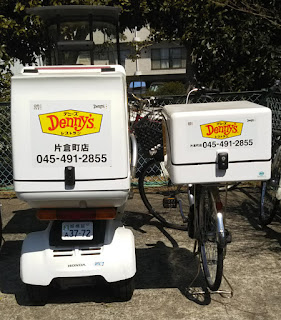HOME TRASH
Alright then, having just moved into a new home, a small
house I’m going to have to dedicate an entire new entry to the subject of
TRASH!
 |
| You don't find many public trash bins |
In Japan, it is customary, when moving into a new
neighborhood, to introduce yourselves to your neighbors by presenting a small
gift, such as a hand towel, and asking them to excuse any noise or
inconvenience created by your moving/delivery trucks. This is what we did and
it gave us the opportunity to learn about trash pick-up and to meet the
self-appointed neighborhood sheriff.
We were out on the street chatting with our closest
neighbors when a feisty ol’ gal, in her 70’s, I would guess, saw us and
approached. She introduced herself and joined the conversation. At one point, I
asked about garbage pick-up and that’s when the sheriff took control of the
conversation.
The sheriff first took us to the end of the street and
pointed out the trash pick-up point that all the houses in the vicinity used.
She then told us we would be expected to join in the trash pick-up point clean
up rotation. This is where folks take turns policing up the trash site. She
then, without another word, walked off…. eh? We continued talking with others,
but about 10 minutes later the sheriff returned. She handed over a full color, six
page, printed on both sides, trash guideline booklet, printed by the City
Office, and it was in English!
 |
| Designated neighborhood pick-up site |
She casually mentioned that there were some other gaijin’s (foreigners) in the neighborhood that didn’t follow the rules properly and she felt obligated to always check their trash for proper procedures.
As noted there is a pamphlet available outlining the
rules regarding trash. Most of the pages are given over to defining what trash
goes into what category and how to prepare it for disposal. Here are some of
the highlights (these relate specifically to Yokosuka. Other municipalities
have their own guidelines).
There are three different pick-up days for different types
of trash, i.e., 1) Burnable refuse, 2) cans, bottles, PET bottles, and 3) non-burnable
refuse. Further, the trash MUST be placed between the hours of 6 a.m. and 8
a.m. You may NOT put it out the night before.
Here are some example quotes from the “bible”:
Burnable Refuse - Please do not use colored bags other than
white bags for disposal.
- Kitchen Garbage – Please drain any liquid before
disposal
- Disposable diapers (please flush the waste down
the toilet first) [kind of defeats the purpose of disposable]
Cans, Bottles, PET bottles
- Please use colorless, transparent bags of 45
liters or less
- Please do not double-bag your garbage
- Please rinse items that have food on them
- Be sure to completely use contents of aerosol
cans before disposal
- Be sure to remove all bottle caps
- If you cut tubes for toothpaste, etc. with scissors,
you can rinse the inside
Non-Burnable refuse
- Please wrap glass and light bulbs in thick
paper, and write “Kiken (Dangerous)/Glass” on it.
- Be sure to use contents of lighters and dispose
of them in a transparent bag separate from other non-burnable refuse.
Note the use of
“Please” – That is actually saying, “If you do other than outlined, your trash
will be tagged and NOT picked-up.
Batteries, such as for flashlights and such, are not accepted. You are expected to return them to the store where purchased.

Then there is the “kitchen sink”. In Japan, they do not use InSinkErators.
In fact, they do not allow food waste to go down the drain at all. The kitchen
sink drains all have a filtering basket that catches bits of food before they
can go down the drain. An additional food waste basket is kept in the sink, off
to the side. Perforated with holes for water drainage and fitted with a
specialty plastic bag that allows water to drain through, this bag allows
collection of the larger bits, where they can be saved until ready for
disposal.
So, when was the last time YOU had to thoroughly wash a Styrofoam meat tray (the kind that your meat comes packaged in from the market)?
With all the complex rules regarding trash it is no wonder
that in public spaces (mentioned in previous postings) business do not put out
trash containers. In downtown Yokohama, there is this monster big public plaza
where thousands of people pass through each hour, yet there is not one single
trash bin to be found, and it is amazingly clean. But it should be said,
anywhere there is a “out-of-sight” nook, opening, or gap, it will generally be
filled with trash.
 |
| Sign of the times |
For further information and some cheap entertainment you can see the online version, in English, of the Yokosuka
Classification brochure.

























































